Several years ago I joined some friends in setting up a chat room called “Cinema vs. Lunch.” It was more performance art than anything; each of us took on an assumed identity and proceeded to invent complicated and often alarming relationships with each other. The outsiders who then wandered in to chat, became our audience. Unsurprisingly, not many stayed long; very surprisingly, most arrived actually eager to discuss the merits of cinema over lunch, or vice-versa. The topic we’d invented as a joke seemed to have had some unforeseen resonance.
I couldn’t help recalling this as I wended my way towards the opening night of Chicago’s first annual Film Food Festival, which intriguingly promised to cater to both the eye and the palate. But could it do so equitably? No matter how they sliced or spliced it, wasn’t one element of the two bound to overwhelm its partner? Film, at its best, offers a genuine catharsis; food, a profound sense of well-being. When you pit one against the other, which wins out? I was anxious to learn.
The festival, which was branching into Chicago after a few successful years in New York, had chosen the motto “See It, Taste It.”
The idea being, you watch a program of short films with culinary themes, and after each entry you get a little sampling of some related delicacy.
We Need a Plan
As my partner Jeffrey and I made our way into the labyrinthine interior of the Museum of Contemporary Arts’ warehouse in the city’s West Loop, we found the feasting already well under way. The low-ceilinged, raw-space enclosure hosted a horde of hungry hipsters, who descended on the hard-working wait staff the second they emerged from the prep room, like vultures not quite waiting for the water buffalo to die.
Against such fierce competition, it was clear we stood a better chance of getting hold of something if we split up. Ten minutes later we reconvened in the center of the room; Jeffrey had managed to score a few paper trays of fried cheese curds, while I’d snagged four North Atlantic oysters. Not exactly the most felicitous combination, but each offering was very good on its own merits (the batter on the curds just oily and salty enough to be pleasant, the oysters sparkling fresh and spritzed with lemon), and as always, a decent wine bonds disparate elements together; in this case, a full-bodied Esporão Riserva cabernet sauvignon from Alentejo, Portugal.
After the band wrapped up its set, we took our seats in the adjoining space for the films. The program opened happily with “Eat Your Fill” by Mark Irving, in which a camera crew followed former adman Phil Wesson to the Wisconsin State Fair, where each year he sets himself the challenge of eating everything that’s either deep-fried or on a stick. He approached the task like an athlete, mocking the kind of inexperienced contender who might “drink a lot of water first,” then plunging into an artery-choking gorge-fest of corn dogs, cheese curds (hence their appearance earlier), artichoke hearts, onion rings, mushrooms, mozzarella bites, deep-fried tomatoes (which he pronounced “outstanding”), and sauerkraut balls (“I’ve gotta be truthful: that’s one of the most disgusting things I’ve ever had”). A calorie meter on the side of the frame kept track of his intake, and boy did he keep those digits spinning.
“I’ve got to counter that sauerkraut,” he protested, and chose as his treatment a deep-fried Oreo. The calorie meter almost started smoking at that one. He followed with a fried banana, a funnel cake, and a pork chop (which, he quipped, isn’t on a stick—“We call that a bone”).
“I can’t eat anymore,” he moaned, yet in the next scene he was wrist-deep in a platter of cream puffs. By this time the calorie meter had hit 2,500, but Wesson headed back to his car not visibly the worse for wear. In fact, he seems to be a pretty trim, energetic guy. Maybe between State Fairs he subsists on melba toast and watermelon. In any case, he was very agreeable company, and this was certainly an experience best enjoyed vicariously.
After the film ended the wait staff passed out—oh hell yeah, you guessed it—deep-fried Oreos. The murmur of approval was certainly vindicating. I wish I could tell you how this rather alarmingly conceived delicacy tasted, but after my first bite I seem to have blacked out for a full thirty seconds. I also temporarily lost both my sight and hearing. We’re talking twelve-gauge eating here. Not for sissies. Of which I am apparently one.
I wish I could tell you how this rather alarmingly conceived delicacy tasted, but after my first bite I seem to have blacked out for a full thirty seconds.
Soda Pop Art
Next up: “Soda Pop,” directed by Meredith Arthur and Eric Slatkin. It’s a profile of John Nese, the owner of Galco’s Soda Pop Stop in Los Angeles. It was the winner of the Audience Choice Award at this year’s New York Food Film Festival, and it was my favorite on tonight’s roster as well.
Wearing shorts, an apron and a smile, Nese leads us through the aisles of his store—where he stocks more than 500 small-run sodas, many from family-owned bottlers—while telling us the story of his fascination with carbonation, dating from a visit to a natural spring during a childhood camping trip.
Nese’s is one of those lives that can’t but strike you as uniquely American: the trajectory is clear from an early age, and the arc is triumphal. There’s even a villain: big business, who have all but seized the entire market and corrupted it with practices like high-fructose corn syrup (“so unnecessary,” says Nese; “cane sugar is the largest single crop in the world, larger than corn and wheat put together”) and plastic bottles (which not only reduce shelf life but alter the contents over time; whereas with glass “the way a product goes in…is the way it comes out”). At one point Nese relates how he gave a rep from Pepsico the heave-ho, concluding “Thank you Pepsi-Cola for reminding me that I own my shelf space and I can do anything I want.”
But Nese’s appeal isn’t as a hero; it’s as master of the revels. He tantalizes us with the names, flavors, and colors of elixirs we never even knew existed. If we like root beer, for instance, we have to try Red Ribbon, “it’s made from the bark of the sassafras…and if you’re looking for a lemon-lime, try Bubble Up, it’s still made with lemon and lime oils.” He recounts how he was approached by a bottler of floral sodas; he warily gave them a try, and was astonished by what he encountered: crisp, clean rose flavor. Nese bought the entire run, then asked what else they had. Turns out they made a cucumber soda, but no one would give it a chance. No one until Nese, that is. Mr. Q. Cumber quickly became one of the prize items on his shelves.
Nese also holds forth on diet sodas (“very bad”), sports drinks (“Ugh”), and environmental issues (“If we really cared about the environment, we’d have reuse, not recycling”). The entire film is worth seeing, and fortunately it’s one of the few festival entries available online.
At the conclusion, the audience was treated to a sampling of Mr. Q. Cumber, and let me tell you, it was a revelation. Sparkling, light, and not too sweet, with a definite cucumber flavor and a wonderfully clean finish; by comparison, 7-Up is battery acid. I could drink this stuff every day. (And its lightness and clarity were especially welcome after that sludgelike Oreo.)
The evening was far from over; we girded our loins and braced for more.
STAY TUNED FOR PART 2: Mr. Okra, Brent Petkau’s oysters, and Hoosier Sugar Cream Pie
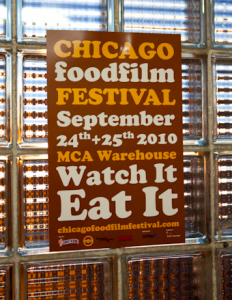
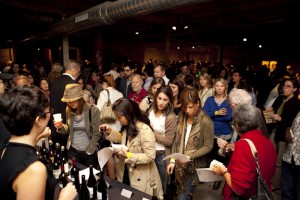
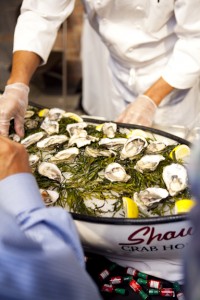
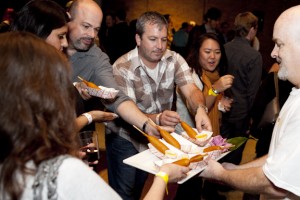
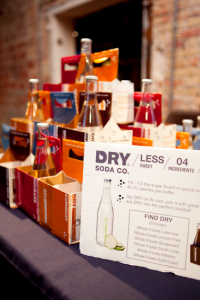
My review of the 1st annual Chicago Film Food Festival: http://www.toquemag.com/featured/chicagos-food-film-festival-part-1